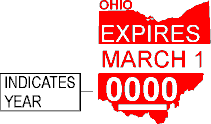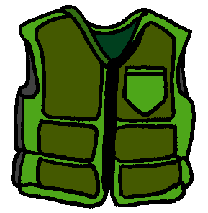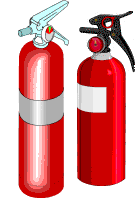
Sailboards (commonly called windsurfers) and manually propelled inflatables without a hull identification number are not considered a watercraft by definition. Therefore, the Ohio registration and titling laws do not apply to these vessels.
Hull Identification Number (HIN)
The HIN is the boat's serial number. It is a 12 character number, a minimum of 1/4 inch high, permanently attached to the upper right of the boat's transom or on the starboard side within two feet of the stern (for boats without a transom). Pontoon boats will have a visible HIN on the aft crossbeam within one foot of the starboard hull attachment.
For homemade boats and watercraft without a HIN, contact the local Watercraft office and apply for a HIN. An appointment with a watercraft officer must be made to inspect the boat before a HIN can be assigned.
Caution must be exercised when buying a boat due to the number of stolen boats. One way to avoid problems is to match the hull identification number (HIN) listed on the title to the one attached to the boat. Before purchasing, inspect the HIN to be sure it has not been altered in any way.
Titling of Watercraft & Outboard Motors
(ORC 1548.03 & 1548.01)
No person is permitted to sell, purchase or otherwise acquire any of the following without a certificate of title:
NOTE: Some watercraft listed above may not have needed a title when it was originally purchased. Prior to selling the watercraft, however, the owner must apply to their county title office and obtain a title. These include:
Watercraft exempt from Ohio numbering are those:
Registration of Watercraft
(ORC 1547.531)
Numbering a watercraft and registering a watercraft are two separate functions. No person shall operate any watercraft without a valid registration. Evidence of this registration is shown by displaying two registration tags and carrying the original registration certificate on board the vessel.
Refer to the registration & titling flow chart for further details.
Before boating, the new owner of a used boat must take the previous registration form with the transfer section completed by the seller to any watercraft registration agent, even if the registration has not expired. However, if a watercraft requiring a title is transferred to a new owner, it may be operated for no more than 45 days provided the new owner carries aboard either of the following:
No person shall operate a documented vessel unless the certificate of documentation is valid and available for inspection. The vessel must display the official number, the vessel name and home port.
Documented vessels must be registered in Ohio and display two Ohio tags, but they are not assigned an Ohio number.
Watercraft Identification & Display of Tags and Number
(OAC 1501:47-1-07 & ORC 1547.57)
The number assigned is in three parts beginning with "OH," followed by four numbers and two letters.
The number shall:
| OH 1234 AB or OH-1234-AB |

The tags must be clearly visible in normal conditions and affixed prior to operation of the watercraft. Documented boats must display one tag on the port side and one on the starboard side.
All tags must be removed when they become invalid (expire).
| Expiration of Registration (ORC 1547.54) Registration certificates and tags are valid up to 3 years and expire on March 1 of the year indicated.
(ORC 1547.57)
(ORC 1547.531) |
 |
Personal Flotation Devices (PFD)
(ORC 1547.25)
No person shall operate or permit to be operated any watercraft:
Each PFD shall be:
 TYPE I |
 TYPE II |
 TYPE III |

|
 TYPE V |
The Coast Guard approval label of some PFDs includes a collision impact rating. It is recommended that persons being towed on skis or other devices and operators of personal watercraft and their passengers wear a PFD with a high impact rating, although it is not a legal requirement.
The PFD must be:
Barefoot Skiing
(ORC 1547.18)
No person shall engage in barefoot skiing without wearing an adequate and effective United States Coast Guard approved Type I, II, III PFD or a Type V PFD specifically designed for water-skiing, in good and serviceable condition, of appropriate size or a wetsuit specifically designed for barefoot skiing. No boat operator shall tow any person who fails to comply with this law.
PFDs Required for Personal Watercraft
(ORC 1547.41)
No person shall operate or permit the operation of a personal watercraft unless each person on the watercraft is wearing a Type I, II, III, or V personal flotation device.
A person operating a personal watercraft that is equipped by the manufacturer with a lanyard type engine cutoff switch shall attach the lanyard to the person, the person's clothing or personal flotation device as appropriate for the specific watercraft.
A "personal watercraft" is defined as a vessel less than 16 feet in length, propelled by machinery and designed to be operated by an individual sitting, standing, or kneeling on the vessel rather than by the individual sitting or standing inside the vessel.
Anchor Requirements
(ORC 1547.26 & OAC 1501:47-1-11)
All watercraft shall carry an anchor and line of sufficient weight and length to anchor the
watercraft securely. No person shall operate or permit to be operated any watercraft in violation of this section.
The following vessels are exempt from requirements to carry an anchor and line:
Powercraft exempted from this requirement are those:
| A United States Coast Guard approved fixed fire extinguisher system installed in the vessel's engine compartment is equal to one B-1 portable fire extinguisher. |
Fire Extinguisher | ||
| CLASSIFICATION | TYPE/SIZE | ||
 |
FOAM (minimum gallons) |
B-I | B-II |
| 1.25 | 2.5 | ||
| CARBON DIOXIDE (minimum pounds) |
4 | 15 | |
| DRY CHEMICAL (minimum pounds) |
2 | 10 | |
| HALON (minimum pounds) |
2.5 | 10 | |
Distress Signals
(ORC 1547.251)
When operating on federally controlled waters (Lake Erie or the immediately connecting bays, harbors, and anchorage areas):
No person shall operate or permit operation of a vessel:
No person shall operate or permit operation of a vessel:
VISUAL DISTRESS SIGNAL OPTIONS | ||
| DESCRIPTION | DAY OR NIGHT USE | |
 | (3) Hand Held Orange Smoke | Day Only |
 | (3) Floating Orange Smoke | Day Only |
 | (1) Orange Flag | Day Only |
 | (3) Hand Held Red Flares | Day & Night |
 | (3) Parachute Red Flares | Day & Night |
 | (3) Red Aerial Pyrotechnic Flares | Day & Night |
 | (1) Electric Distress Signal | Night Only |
NOTE: Distress signaling devices must comply with ORC 1547.69 regarding firearm restrictions, which state no person shall knowingly transport or possess a distress signaling device in a loaded condition on a vessel other than immediately prior to discharge of the device for the purpose of signaling for assistance.
Exempted vessels during daylight hours only include:
Backfire Flame Arrestor
(ORC 1547.28)
Every gasoline engine installed in a vessel, except an outboard motor, shall be equipped with an acceptable device to control backfire flame.
The device shall be:
No person shall operate or give permission to operate a powercraft in a manner to exceed the following noise levels:
Vessel Sanitary Systems
(ORC 1547.33)
Except on Lake Erie, the Muskingum River and the Ohio River, no person shall launch, moor,
dock, operate, or permit to be operated any vessel with a sink, toilet, or sanitary system capable of discharging urine,
fecal matter, contents of a chemical commode, kitchen wastes, laundry wastes, slop sink
drainage, or other household wastes into the waters in this state. Such a sink, toilet, or sanitary
system shall be removed or sealed or made to drain into a tank or reservoir that can be carried or
pumped ashore for disposal in an approved sewage treatment works. |
 |
Equipment for Sound Signals
(ORC 1501:47-2-33)
A vessel of 12 meters (39.4 feet) or more in length shall be provided with a power whistle or power horn and a bell.
A vessel less than 12 meters in length shall not be obliged to carry the sound devices described in the preceding paragraph. However, the vessel must be provided with a means of making an efficient sound signal.
A vessel that is propelled by human muscular effort, a sailing vessel and a power-driven vessel less than 16 feet in length, when using waters other than Lake Erie, the Ohio or Muskingum River, shall not be obliged to carry the sound devices stipulated above or produce the sound signals prescribed in the Ohio Administrative Code.
Navigation Lights
(OAC 1501:47-2-21 through 1501:47-2-31)
All vessels are required to display running lights or an anchor light between sunset and sunrise.
For power vessels, running lights include a green light displayed on the starboard side, a red light
displayed on the port side and all-around white light(s) displaying 360 degrees. An anchor
light is an all-around white light. Requirements vary by vessel size and type. Sailing vessels and
hand-powered vessels have light display options. Lighting requirements are covered in greater
detail under Navigation Rules.